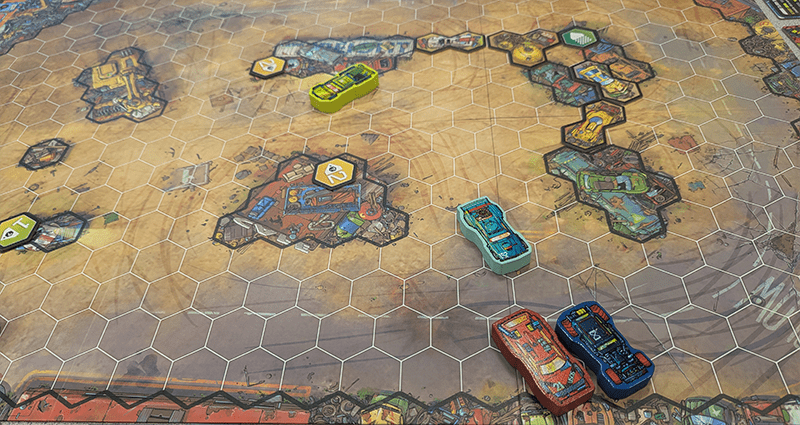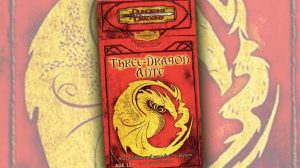Disclosure: Meeple Mountain received a free copy of this product in exchange for an honest, unbiased review. This review is not intended to be an endorsement.
Trends aren’t new to board gaming. Generic fantasy, nature themes, vikings, ninjas, and anthropomorphic animals have littered the landscape for years. Post-apocalyptic racing is one of those popular niches, thanks largely to the enduring influence of Mad Max movies and games like Thunder Road: Vendetta. Joyride: Survival of the Fastest aims to compete in this crowded arena by being unconventional.
The unconventional approach is obvious at first glance: there’s no track. Instead, checkpoints are placed around large open play areas to create racing routes. The game includes pre-made layouts in a separate rulebook, but players can design their own if they want more control. Drivers navigate from checkpoint to checkpoint while grabbing combat items to either boost their own position or sabotage their rivals. Basically, this is Mario Kart having an awkward love affair with the fine sport of destruction derby.
The offbeat style extends to vehicle selection as well. Each car functions like a character in a fighting game, with unique abilities that can’t be modified or customized. Choose your ride carefully: one might specialize in throwing junk around the track, while another excels at taking risks or being flexible in tight turns. This fixed design means every vehicle demands a different approach, and plenty of replayability to enjoy as you watch these unique cars clash with each other on the track.

No Track, No Problem
Movement is where fate enters the equation. Players roll dice to move, with each die going from 1 to 3. The gear you are on represents the number of dice you roll, and you must move that number of spaces in a mostly straight line. Unless you are in second gear, you can only steer your car in one direction in the two movement phases the game provides: Lock and Roll.
The movement system is more nuanced than a simple roll-and-move. Your dice pool, tracked in your ‘rear view mirror,’ carries over from turn to turn. Each turn begins by locking some dice from your previous roll, moving that distance without touching the dice. Then you decide whether to gun it by adding more dice or pump the brakes by removing some through gear shifting. Finally, roll whatever remains in your pool and move forward again. It’s a clever system that gives you control while maintaining that wonderful bit of uncertainty.
I can imagine some readers groaning at that last paragraph. Push-your-luck racing games are hardly new, and that’s a fair observation. But what makes Joyride’s system work is one simple element: collisions.
Fortunately, the game includes helpful player aids. One side shows the turn phases, while the other lists the different collision types you’ll be dealing with constantly. The key is that your vehicle occupies two hexagonal spaces, and where an opponent hits you determines what happens. Rear collisions push you forward. Side impacts rotate your car. This isn’t just chrome on top of a racing game. This is the heart of Joyride.
Lock and Roll, Baby
The combination of strict steering and hex-based movement also makes racing lines critical. Most racing games handle positional battles through special rules. Joyride takes a more direct approach. Want the optimal line? Physically shove your opponents out of the way. A well-timed collision can nudge a rival off course or, even better, rotate them to face the wrong direction.
This is where the divide emerges between players who love Joyride and those who hate it. I have to confess that most of the players I conscripted into trying this weren’t fans, primarily because of the collision system. The movement mechanics sound quite limiting at first glance, so getting knocked off-course can feel like a death sentence. It takes a few plays to grasp the subtle nuances and discover solutions to the problems you’ll inevitably face.
Problems like using the engine brake to intentionally damage your car, dropping two gears to regain your double steering per turn. Going too fast? Just rear-end the car in front of you and use them as brakes and maybe push them into an explosive mine. Your vehicle’s unique abilities become valuable escape tools, helping you slip out of trouble or maintain momentum. Weapons also turn the tide, damaging opponents and slowly chipping away at their progress.
Damage is handled brilliantly. Cars can’t be destroyed, but each nasty hit forces you to place a damage chip on your dashboard, covering up one of your features permanently. Lose a locked dice slot. Lose an item slot. Lose access to your highest gear. It feels devastating, yet the game remains winnable even with a car held together by duct tape and spite. I’ve been in races where my car had 99 problems and winning the race wasn’t one of them, or a player reversing into the finish line after getting sideswiped by another player in a previous turn.

The Fast and the Furious (At Each Other)
Joyride is decidedly for players with acquired tastes. Those craving pure chaos will find themselves bogged down by systematic rules and careful movement planning. Meanwhile, strategy-focused players will bristle at how a single collision or well-timed weapon deployment can unravel their perfectly calculated approach. The game tries to serve two masters at once, and not everyone will appreciate the compromise. To some, this feels like thoughtful design that rewards adaptability. To others, it reads as an identity crisis, a game unsure whether it wants to be a tactical racing puzzle or a gleeful demolition derby.
The game can also stumble into analysis paralysis, especially with players who misunderstand what they’re signing up for. The hex grid and multiple movement phases suggest deep tactical possibilities, tempting players to calculate every potential outcome. While that is understandable, most of the movement is dictated by dice rolls, not careful planning. Treating Joyride like a chess match with missiles and airstrikes will bog down the game for everyone. The reality is people should embrace randomness and make gut choices rather than pointless calculations.
The game’s inherent inconsistency can lead to frustrating sessions. Despite all the weapons and collision mechanics designed to keep things competitive, Joyride struggles to maintain a tight pack. A player who gets a strong early lead and avoids major setbacks can be difficult to reel back in. Most of the weapons used in this game are designed to mess people within close proximity. The Airstrike might appear to be the “blue shell” weapon in Joyride but it’s much easier to avoid than you think. The chaos that defines the game isn’t always chaotic enough to level the playing field.
The Road Warrior’s Dilemma
These balance issues become even more pronounced at certain player counts. Joyride is clearly designed with three or four players in mind, and it shows most at four. The publishers seem aware of this limitation, having released a standalone two-player version to address the gap. To the game’s credit, there is a 2v2 team mode that offers a different dynamic if you want to switch things up. But if you’re mainly a two-player household, the base game won’t deliver the same experience as a full table.
Yet here I am, returning to Joyride despite its issues. That persistence means something. The collision mechanics generate moments unlike anything else in racing board games. Where else can you treat rear-ending and sideswiping as core tactical decisions rather than accidents? The game insists on being both calculated and chaotic at once, and that inherent tension shapes everything. If that sounds appealing rather than exhausting, Joyride offers something legitimately fresh. The question isn’t whether Joyride is quality design. The question is whether it fits your table.











